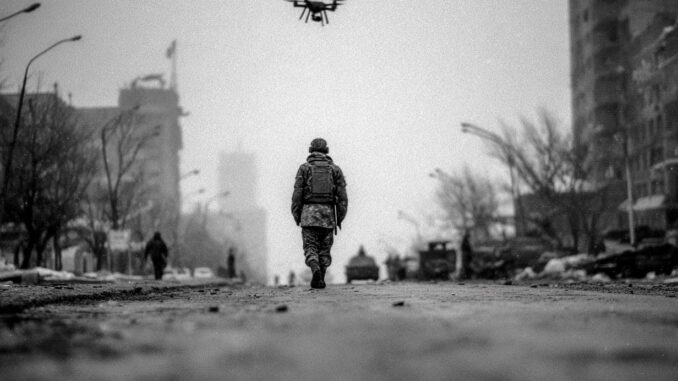
Russia is developing a large-scale drone industry combining state support, SMEs, schools, and dual production for civilian and military purposes.
An industrial strategy led by the Russian government
Since 2022, the Russian government has been building a complete ecosystem dedicated to drone production. The stated goal is to become an autonomous technological power in the unmanned aerial vehicle (UAV) sector, while ensuring rapid adaptation to the requirements of the Ukrainian battlefield. This policy is based on three main levers: massive public funding, the integration of small businesses, and training from an early age in aerial robotics.
The sector will receive 243 billion rubles (approximately $3 billion) in funding between 2022 and 2025, with an additional 112 billion rubles until 2028. This sum is separate from the defense budget, which already accounts for nearly a third of federal spending.
A network of SMEs mobilized for dual production
The Russian model is unique in its active integration of small and medium-sized enterprises (SMEs). According to official data, nearly 70% of the 900 companies involved in drone production are medium-sized businesses. They employ around 7,000 people, often from civilian sectors that have been redirected to military use.
Companies such as Albatross, which initially specialized in agriculture, have developed surveillance drones for the army based on modified civilian platforms. Others, such as Integrated Robotics Technologies, claim to produce industrial drones while discreetly supplying remote-controlled ammunition for Russian forces, sometimes referred to on Telegram as “single-use vehicles.”
These companies are encouraged to produce so-called “dual-use” systems, officially designed for logistics or infrastructure surveillance, but easily adaptable for targeted strikes or offensive intelligence.

Direct involvement of the Russian education system
The development strategy also involves technical education starting in secondary school. At the initiative of the Agency for Strategic Initiatives, many schools in Russia have introduced courses in drone design and piloting, often in partnership with companies linked to the defense industry.
These programs are supported by public sponsors such as Rosatom, Rostec, and Almaz-Antey, and sometimes offer benefits to students, such as bonus points on exams, professional internships, or priority hiring. In some cases, prototypes produced during these training programs have been used in actual military operations.
The teachers involved acknowledge that the official line is that these programs are for civilian use, but that the military purpose remains implicit in most competitions and events.
Centralized production, geographically dispersed
The Russian government has also invested in eleven specialized regional centers, funded by 21 billion rubles until 2027. These hubs are located in special economic zones, close to existing industrial or technological infrastructure: Saint Petersburg, Perm, Tomsk, and Tatarstan.
This geographical dispersion is intended to ensure resilience, preventing a single strike from neutralizing the entire industrial capacity. This principle, referred to by some analysts as a strategy of “industrial depth”, is directly inspired by Soviet doctrine.
Each center specializes in a segment of the production chain: engines in Perm, embedded electronics in Tomsk, design and R&D in Moscow and Saint Petersburg. However, the site in Yelabuga (Tatarstan) is the heart of the operation.
A giant factory for Geran-2 offensive drones
The Yelabuga site, part of the Alabuga special zone, is home to the largest production facility for kamikaze drones in Russia. According to satellite images and leaked documents, two 700-meter production lines have been set up to manufacture the Geran-2, a derivative of the Iranian Shahed-136.
These delta-wing drones, equipped with a large explosive payload, are used in regular strikes against Ukrainian cities. Their low unit cost (a few thousand dollars) and their ability to overwhelm defenses make them effective in a war of attrition.
Production is reportedly running in three shifts per day, with an estimated capacity of several hundred units per month. The nearby industrial zone plans housing for thousands of workers, with rumors of the use of North Korean labor.
Tehran’s support and the strategy of technological autonomy
The Yelabuga plant has benefited from Iranian support, particularly in the form of manufacturing plans, materials, and electronic components. Tehran has transferred its expertise in drones, used in Yemen, Syria, and Lebanon, to support a rapid ramp-up of Russian production.
This partnership is part of a broader strategy known as import substitution: producing all critical components locally, from engines to microcontrollers. However, Russia remains dependent on imported electronic components, particularly from China, which is a major weakness in its industrial autonomy.
Despite Western sanctions, Russian manufacturers are managing to circumvent restrictions through front companies in third countries. This method allows them to supply the production chain with critical components, but limits access to advanced technologies, particularly in microengraving.
A stated goal of global leadership by 2030
Vladimir Putin stated in 2024 that he wanted to make Russia a leading player in the field of drones by 2030. The increase in production in 2024, estimated at 2.5 times higher than in 2023, confirms an accelerated industrial momentum. Some Ukrainian sources even suggest a further threefold increase in the first half of 2025.
In addition to domestic use, Russia is considering exporting its drones, including to isolated countries and those under sanctions. The waiver of VAT on drones and their components decided by the Duma is a step in this direction, facilitating the commercial circulation of these systems, whether civilian or military.
This export potential also concerns North Korea, to which Moscow could transfer assembly lines in exchange for labor or mineral resources.
War Wings Daily is an independant magazine.